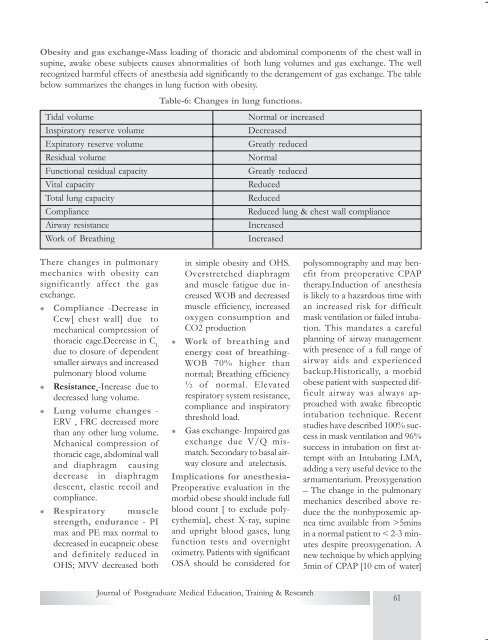National Board Ex- 6 Book .pmd - National Board Of Examination
National Board Ex- 6 Book .pmd - National Board Of Examination
National Board Ex- 6 Book .pmd - National Board Of Examination
Create successful ePaper yourself
Turn your PDF publications into a flip-book with our unique Google optimized e-Paper software.
Obesity and gas exchange-Mass loading of thoracic and abdominal components of the chest wall insupine, awake obese subjects causes abnormalities of both lung volumes and gas exchange. The wellrecognized harmful effects of anesthesia add significantly to the derangement of gas exchange. The tablebelow summarizes the changes in lung fuction with obesity.Table-6: Changes in lung functions.Tidal volumeNormal or increasedInspiratory reserve volumeDecreased<strong>Ex</strong>piratory reserve volumeGreatly reducedResidual volumeNormalFunctional residual capacityGreatly reducedVital capacityReducedTotal lung capacityReducedComplianceReduced lung & chest wall complianceAirway resistanceIncreasedWork of BreathingIncreasedThere changes in pulmonarymechanics with obesity cansignificantly affect the gasexchange.l Compliance -Decrease inCcw[ chest wall] due tomechanical compression ofthoracic cage.Decrease in C Ldue to closure of dependentsmaller airways and increasedpulmonary blood volumel Resistance -Increase due todecreased lung volume.l Lung volume changes -ERV , FRC decreased morethan any other lung volume.Mchanical compression ofthoracic cage, abdominal walland diaphragm causingdecrease in diaphragmdescent, elastic recoil andcompliance.l Respiratory musclestrength, endurance - PImax and PE max normal todecreased in eucapneic obeseand definitely reduced inOHS; MVV decreased bothin simple obesity and OHS.Overstretched diaphragmand muscle fatigue due increasedWOB and decreasedmuscle efficiency, increasedoxygen consumption andCO2 productionl Work of breathing andenergy cost of breathing-WOB 70% higher thannormal; Breathing efficiency½ of normal. Elevatedrespiratory system resistance,compliance and inspiratorythreshold load.l Gas exchange- Impaired gasexchange due V/Q mismatch.Secondary to basal airwayclosure and atelectasis.Implications for anesthesia-Preoperative evaluation in themorbid obese should include fullblood count [ to exclude polycythemia],chest X-ray, supineand upright blood gases, lungfunction tests and overnightoximetry. Patients with significantOSA should be considered forpolysomnography and may benefitfrom preoperative CPAPtherapy.Induction of anesthesiais likely to a hazardous time withan increased risk for difficultmask ventilation or failed intubation.This mandates a carefulplanning of airway managementwith presence of a full range ofairway aids and experiencedbackup.Historically, a morbidobese patient with suspected difficultairway was always approachedwith awake fibreopticintubation technique. Recentstudies have described 100% successin mask ventilation and 96%success in intubation on first attemptwith an Intubating LMA,adding a very useful device to thearmamentarium. Preoxygenation– The change in the pulmonarymechanics described above reducethe the nonhypoxemic apneatime available from >5minsin a normal patient to < 2-3 minutesdespite preoxygenation. Anew technique by which applying5min of CPAP [10 cm of water]Journal of Postgraduate Medical Education, Training & Research61
















